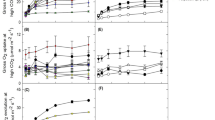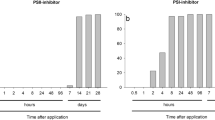Abstract
The depressions of photosynthetic CO2 uptake following O3 exposures of 200 and 400 nmol mol-1 for between 4 and 16 h were compared between Pisum sativum, Quercus robur and Triticum aestivum, and the potential causes of change identified in vivo. Photosynthetic change was examined by analysis of CO2, O2, O3 and water vapour exchanges together with chlorophyll fluorescence in controlled environments. Under identical fumigation conditions, each species showed very similar rates of O3 consumption. The light-saturated rate of CO2 uptake showed a statistically significant decrease in each species with increasing O3 dose. Although stomatal conductance declined in parallel with CO2 uptake this did not account for the observed decrease in photosynthesis. The decrease in mesophyll conductance resulted primarily from a decrease in the apparent carboxylation capacity, implying in decreased activity of ribulose 1,5-bisphosphate carboxylase/oxygenase. The maximum capacity of carboxylation was consequently reduced by over 30% and 50% after 16 h fumigation with 200 and 400 nmol mol-1 O3 respectively. Additionally, in Q. robur, a statistically significant inhibition of the CO2 saturated rate of photosynthesis occurred after 16 h with 400 nmol mol-1 O3, suggesting that the ability to regenerate ribulose 1,5-bisphosphate was also impaired. None of the species showed any significant decrease in the efficiency of light-limited photosynthesis following fumigation at 200 nmol mol-1 O3, but effects were apparent at 400 nmol mol-1 O3. The common feature in all three species was a decline in carboxylation capacity which preceded any other change in the photosynthetic apparatus.
Similar content being viewed by others
Abbreviations
- Asat :
-
net CO2 uptake rate per unit leaf area at light saturation
- A:
-
net CO2 uptake rate per unit leaf area
- Amax :
-
net CO2 uptake rate per unit leaf area at CO2 and light saturation
- ci :
-
mole fraction of CO2 in the intercellular air space
- gs :
-
stomatal conductance to CO2
- Fm :
-
maximum chlorophyll fluorescence
- Fv :
-
variable chlorophyll fluorescence
- φc :
-
quantum yield of CO2 uptake for absorbed light
- φ0 :
-
quantum yield of oxygen evolution for incident light
- PPFD:
-
photosynthetically active radiation
- Rubisco:
-
ribulose 1,5-bisphosphate carboxylase/oxygenase
- RuBP:
-
ribulose 1,5-bisphosphate
- Vcmax :
-
maximum rate of carboxylation
References
Aarnes H, Baumann C, Eriksen AB, Solås A, Sundbye A and Sølvernes KA (1993) Photosynthesis in ozone-exposed duckweed (Lemna gibba). Physiol Plant 87: 256–262.
Aben JMM, Janssen-Jurkovicova M and Adema EH (1990) Effects of low level ozone exposure under ambient conditions on photosynthesis and stomatal control of Vicia faba L. Plant Cell Environ 13: 463–469.
Arnon D and Hoagland DR (1940) Crop production in artificial culture solutions and in soils with special reference to factors influencing yields and absorption of inorganicnutrients. Soil Sci 50: 463–484.
Chevone BI and Yang YS (1985) CO2 exchange rates and stomatal diffusive resistance in soybean exposed to O3 and SO2. Can J Plant Sci 65: 267–274.
Darrall NM (1989) The effect of air pollutants on physiological processes in plants. Plant Cell Environ 12: 1–30.
Davis DD and Wilhour RG (1976) Susceptibility of Woody Plants to Sulphur Dioxide and Photochemical Oxidants. A Literature Review. Corvallis Environ Res Lab. US Environ Protect Agency, EPA-660/3-76-102.
Enyedi AJ, Eckardt NA and Pell EJ (1992) Activity of Ribulose bisphophate carboxylase/oxygenase from potato cultivars with differential response to ozone stress. New Phytol 122: 493–500.
EPA (US Environmental Protection Agency) (1976) The photochemical oxidants. In: Diagnosing Vegetation Injury Caused by Air Pollution. Appl Sci Assoc Inc EPA Contr 68-02-1344.
Farage PK, Long SP, Lechner E and Baker NR (1991) The sequence of change within the photosynthetic apparatus of wheat following short-term exposure to ozone. Plant Physiol 95: 529–535.
Farquhar GD, vonCaemmerer S and Berry JA (1980) A biochemical model of photosynthetic CO2 assimilation in leaves of C3 species. Planta 149: 78–90.
Farquhar GD and Sharkey TD (1982) Stomatal conductance and photosynthesis. Annu Rev Plant Physiol 33: 317–345.
Guderian R, Tingey DT and Rabe R (1985) Effects of photochemical oxidants on plants. In: Guderian R (ed) Air Pollution by Photochemical Oxidants, pp 129–334. Springer, Berlin, Heidelberg, New York.
Heath RL (1994) Possible mechanisms for the inhibition of photosynthesis by ozone. Photosynth Res 39: 439–451.
IPCC (1992) Climate Change 1992. The Supplementary Report to the IPCC Scientific Assessment. Houghton JT, Callander BA and Varney SK (eds). IPCC, Cambridge University Press, Cambridge.
Ireland CR, Long SP and Baker NR (1989) An integrated apparatus for the simultaneous measurement of photosynthetic CO2 and water vapour exchange, light adsorption and chlorophyll fluorescence of attached leaves. Plant Cell Environ 12: 947–958.
Landry LG and Pell EJ (1993) Modification of Rubisco and altered proteolytic activity in O3-stressed hybrid poplar (Populus maximowizii x trichocarpa). Plant Physiol 101: 1355–1362.
Lefohn AS (1992) Surface level ozone exposures and their effects on vegetation. Lewis Publishers Inc., Chelsea, MI.
Lehnherr B, Grandjean A, Mächler F and Fuhrer J, (1987) The effect of ozone in ambient air on ribulosebisphosphate carboxylase/oxygenase activity decreases photosynthesis and grain yield in wheat. J Plant Physiol 130: 189–200.
Lehnherr B, Mächler F, Grandjean A and Fuhrer J (1988) The regulation of photosynthesis in leaves of field-grown spring wheat (Triticum aestivum L., cv Albis) at different levels of O3 in ambient air. Plant Physiol 88: 1115–1119.
Mansfield TA (1973) The role of stomata in determining the responses plants to air pollutants. Commentaries in Plant Science 2: 11–20.
Manning WJ and Krupa SV (1992) Experimental methodology for studying the effects of ozone on crops and tress. In: Lefohn AS (ed) Surface Level Ozone Exposures and Their Effects on Vegetation, pp 93–156. Lewis Publishers Inc., Chelsea, MI.
Mclaughlin SB and Taylor GE (1981) Relative humidity: Important modifier of pollutant uptake by plants. Science 211: 167–169.
Moldau H, Sber J and Sober A (1990) Differential sensitivity of stomata and mesophyll to sudden exposure of bean shoots to ozone. Photosynthetica 24: 446–458.
Nakamura H and Saka H (1978) Photochemical oxidants injury in rice plants. Jpn Crop Sci 47: 704–714.
Nie G-Y, Tomasevic M and Baker NR (1993) Effects of ozone on the photosynthetic apparatus and leaf proteins during leaf development in wheat. Plant Cell Environ 16: 643–651.
Pell EJ and Brennan E (1973) Changes in respiration, photosynthesis, adenosine 5′-triphosphate, and total adenylate content of ozonated pinto bean foliage as they relate to symptom expression. Plant Physiol 51: 378–381.
Pell EJ and Pearson NS (1983) Ozone-induced reduction in quantity of ribulose-1,5-bisphosphate carboxylase in alfalfa foliage. Plant Physiol 73: 185–187.
Pell EJ, Eckardt N and Enyedi AJ (1992) Timing of ozone stress and resulting status of ribulose bisphosphate carboxylase/oxygenase and associated net photosynthesis. New Phytol 120: 397–405.
Pell EJ, Eckardt NA and Glick RE (1994) Biochemical and molecular basis for impairment of photosynthetic potential. Photosynth Res 39: 453–462.
Roper TR and Williams LE (1989) Effects of ambient and acute partial pressures of ozone on leaf net CO2 assimilation of fieldgrown Vitis vinifera L. Plant Physiol 91: 1501–1506.
Temple PJ (1986) Stomatal conductance and transpirational responses of field-grown cotton to ozone. Plant Cell Environ 9: 315–321.
VonCaemmerer S and Farquhar GD (1981) Some relationships between the biochemistry of photosynthesis and the gas exchange of leaves. Planta 153: 376–387.
Wullschleger SD (1993) Biochemical limitations to carbon assimilation in C3 plants — a retrospective analysis of the A/Ci curves from 109 species. J Exp Bot 44: 907–920.
Yang YS, Skelly JM and Chevone BI (1983) Effects of short-term ozone exposure on net photosynthesis, dark respiration, and transpiration of three eastern white pine clones. Environ Int 9: 265–269.
Author information
Authors and Affiliations
Rights and permissions
About this article
Cite this article
Farage, P.K., Long, S.P. An in vivo analysis of photosynthesis during short-term O3 exposure in three contrasting species. Photosynth Res 43, 11–18 (1995). https://doi.org/10.1007/BF00029457
Received:
Accepted:
Issue Date:
DOI: https://doi.org/10.1007/BF00029457




